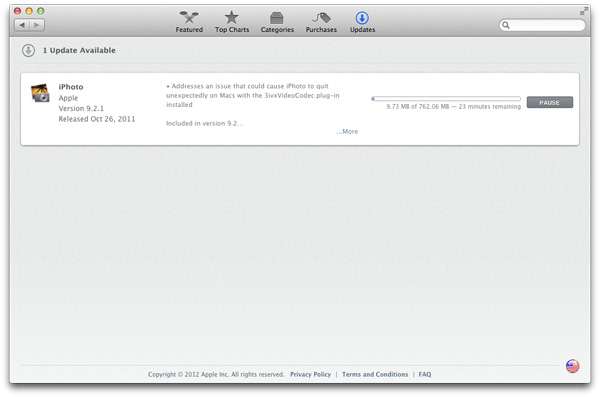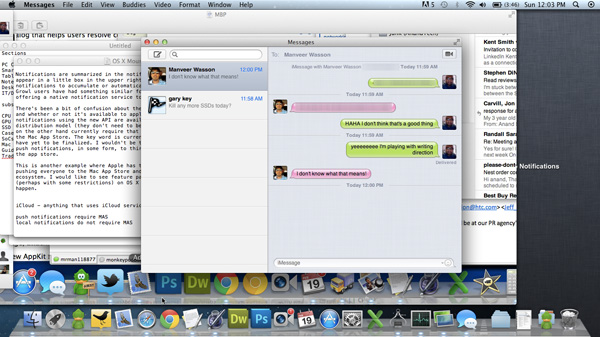Thoughts on the Mac OS X Mountain Lion Developer Preview
by Andrew Cunningham & Anand Lal Shimpi on February 19, 2012 7:40 PM EST- Posted in
- Mountain Lion
- Mac
- macOS
Software Updates & Moving Toward the Mac App Store
To be honest, I rarely use the Mac App Store. I appreciate it because it does let me quickly get Apple applications without fumbling for a restore DVD somewhere, but otherwise I get all of my non-Apple apps directly from the source. The app store makes sense to me on iOS because that's the only option we were presented with from the start, but even there I would appreciate the flexibility of installing apps from any source. On a Mac the opposite is true. Just as was the case on PCs, I've always grabbed and installed software on my Macs from a multitude of sources and I've never really wished there was a centralized, policed repository of Mac applications. That being said, I do understand and accept that I may be a part of a shrinking minority. Apple's most successful products have been those sold effectively as appliances. The MacBook Air took many steps in the same direction by offering no end user upgradeable CPU, memory, storage or battery options. With the MBA you're buying some sort of a Mac appliance hybrid. It's a good device (I'm typing this article on an MBA now), but in many ways it's an inflexible one.
My fear is that as Apple straddles this line between the old and the new, that it will step over too far into the walled garden/appliance territory. That OS X, just like iOS, will become a platform powered only by the app store. That isn't the reality today and I hope that it never will be, but the temptation is surely there. Apple gets a cut of all software sales through the Mac app store, it doesn't elsewhere. App stores are a way of continuing to profit off of a platform after you've sold the initial hardware and operating system. From a customer experience standpoint there's also significant motivation behind supporting only a centralized app store. With complete control of what can run on the platform, Apple could guarantee and maintain the level of experience that it's always been in pursuit of.
Again, today, this isn't a problem but there's definitely movement in that direction. Mountain Lion does away with Lion's Software Update mechanism and instead integrates that into the Mac App Store directly.

There's no change in functionality, just a change in physical location. I will admit that the software update tool always felt like it needed...updating, but I don't know that I would've put it in the MAS application.

Remember all of the new APIs that developers now have access to? A couple of them are only available to applications distributed via the Mac App Store. The big one is iCloud. Any application that interfaces with or uses iCloud is required to be in the MAS. It's the tradeoff you make when you start using Apple's cloud storage as a selling feature of your application. There are ways around this requirement (you could decouple any cloud storage features from your main application and simply offer the former through the app store) but it's a bifurcation of the Mac software feature set for the most part.
The notification story is a little different.
New Notifications API & Interface
Revamping notifications was a major part of the iOS 5 update last year and Apple decided to bring some of that to OS X. Mountain Lion sports a new iPad-like notification center that's accessible by performing a right to left, two finger swipe on a multitouch trackpad. The gesture is unique in that it's the first gesture that must be started at the very edge of the trackpad. A two finger right-left swipe starting in the middle or even an inch from the border of the trackpad is different entirely. To bring up the notifications menu you have to start the gesture at the very edge of the trackpad. It's easier to just start swiping off of the trackpad first, allowing the gesture to then continue onto the trackpad surface. The notification center gesture is very reminiscent of the PlayBook/webOS bezel gestures that have similar requirements for starting outside or at the beginning of the touch area.

Notifications are summarized in the notification center but as they happen they appear in a little box in the upper right of your screen. You can configure notifications to accumulate or automatically disappear after a short period of time. Growl users have had something similar for a while now, but Apple is now officially offering a native notification service to all developers.
There's been a bit of confusion about the new notifications API (NSUserNotification) and whether or not it's available to applications not in the Mac App Store. Local notifications using the new API are available to third party apps regardless of their distribution model (they don't need to be in the Mac App Store). Push notifications on the other hand currently require that the application is distributed only through the Mac App Store. The key word is currently because a lot of Mountain Lion decisions have yet to be finalized. I wouldn't be too surprised if Apple decides to open up push notifications, in some form, to third party applications not distributed through the app store.
This is another example where Apple has to carefully straddle the line between pushing everyone to the Mac App Store and not abandoning the rest of the Mac software ecosystem. I would like to see feature parity regardless of distribution model (perhaps with some restrictions) on OS X going forward, but I'm not sure that will happen.










96 Comments
View All Comments
B3an - Sunday, February 19, 2012 - link
Completely agree. I develop apps for other platforms but will never develop for OSX, it's obvious where things are heading here. And jumping through Apples hoops to get your app on iOS is a nightmare, so i've stopped that too.MS will have an App Store for Win 8 but thats just for Metro, and atleast it's easier to deal with and get your app on there, plus i cant ever see MS doing anything like this to desktop apps. If anything it gives MS even more reason not to, so developers and people have an alternative and a better option. Theres always Linux, but we all know that wont be going anywhere even near to 5% market share any time soon.
ex2bot - Monday, February 20, 2012 - link
I think you misunderstand the signed applications option. They don't have to be in the Mac App Store, the developer just needs to pay Apple $100 for an ID.I love Apple! There awsome!
Who do you love, microsoft? There awsom to! And much less evil than apple.
And, by the way, this really is . . . the end.
Ex2bot
Mac Fanbot
GotThumbs - Monday, February 20, 2012 - link
Love? You appear to live outside of reality. An OS is a tool for accessing applications for work and entertainment, It's NOT a relationship. Either you prefer one OS over the other. That's your choice. Don't be disillusioned about what Apple and MS are...They are companies in the business to make money....and they are very good at marketing to consumers. Just don't drink the Cool-Aid.Best wishes
MobiusStrip - Tuesday, February 21, 2012 - link
Not to mention that it's ANOTHER $100, even if you've already paid for your developer membership for iOS. Lame.ex2bot - Tuesday, February 28, 2012 - link
They send me all that stuff for free. You know, inner circle (shhh!).ex2bot - Tuesday, February 28, 2012 - link
No, I prefer iced green tea. Slightly sweetened. Yum.KoolAidMan1 - Monday, February 20, 2012 - link
The problem with your post is that developers don't need to sell through the App Store to benefit from Gatekeeper.Any applications that are from the App Store or signed with a developer certificate (the free one you get for registering with Apple) can be launched without any warning with Gatekeeper's default settings. If you want to launch an app that hasn't been signed then you either get a UAC style warning, or you can just turn Gatekeeper off globally.
The entire point is that Apple wants to be able to blacklist developers who write malware. Mountain Lion does a check of that blacklist once a day. Without this security method, Apple can only blacklist app identifiers, which take 5 seconds to change, and even malware can adapt to work around that (simply hijack safe identifiers). But there is no easy way for malware to hijack other developer's certificates because they are encrypted like any other security certificate is.
In one fell swoop Apple gains control of easily blocking malware, all while making it brain-dead simple for developers since they can be whitelisted without even needing to release their software through the App Store (your concern).
If a developer chooses not to get on the whitelist, they can still release their software and users (the same ones technically savvy enough to turn off Gatekeeper or manually dismiss it per application) can install it themselves. They'd just get a UAC style warning like they do right now if they want to manually dismiss it.
Lots of worry about nothing.
repoman27 - Monday, February 20, 2012 - link
"...If your non-Mac app store app doesn't have access APIs reserved only for those who distribute through the App Store than you are at a serious disadvantage thus you need to make a version for the app store.Doing so you basically scar your customers who buy directly, basically forcing you to give Apple 30% and go through the app store."
The API's that require Mac App Store distribution are the ones that use Apple's servers. I don't think it's a mystery as to why they want a bit of the action in return for this privilege.
As was noted in the article, the developer can just produce a small add-on module for the Mac App Store if they want to leverage the reserved API's. If they make the add-on free, they only have to pay Apple $99 annually. No one gets "scarred" in the process.
Gatekeeper is merely an attempt at protecting users from their own actions. It's not much different than Windows User Account Control—just another way to deal with the age old problem of giving administrative privileges to the accounts that many people use 100% of the time. If Apple came out with an OS that didn't allow the end user to have elevated privileges at all, that would be much more sinister (like iOS).
kmmatney - Tuesday, February 21, 2012 - link
The App store is good for a majority of people. I have to admit that when I try Linux, I always have trouble installing Apps, and the "App Store", or Software Center is by far the easiest way to get Apps installed. I remember trying to run Linux without centralized application management, and it was a nightmare for me, as least for a Linux noob like me.MobiusStrip - Tuesday, February 21, 2012 - link
Holding Linux software installation out as any kind of comparison is ludicrous. A much better example would be Windows, which has had excellent installers for many years. It has also had UNINSTALLERS, which OS X inexplicably still lacks after a decade.Double-clicking to launch an installer is plenty "elegant" and has been understood even by noobs for many years. Ignoring that fact is a weak strawman.